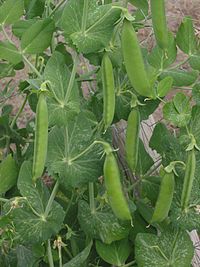
Photo from wikipedia
Understanding how functional traits vary across space and time is important to elucidate fundamental ecological processes determining species diversity, community structure and ecosystem functioning. The advent of the Anthropocene and… Click to show full abstract
Understanding how functional traits vary across space and time is important to elucidate fundamental ecological processes determining species diversity, community structure and ecosystem functioning. The advent of the Anthropocene and its different influences on the environment, and thus on organisms in affected environments, has increased the urgency to gain a more mechanistic understanding of community ecology using trait-based approaches (Schimel, Asner & Moorcroft 2013). Functional traits are morphological, physiological, behavioural or phenological traits that impact fitness indirectly via their effects on growth, reproduction and survival, the three components of individual fitness (Violle et al. 2007), and are thereby directly linked to a species’ responses to anthropogenic threats. Recently, functional traits have been used successfully to predict competitive outcomes between native and invasive species (Funk & Wolf 2016) and introduction biases of alien species through human-mediated transport (Capellini, Allen & Sally 2015). Similarly, the information on traits might improve predictions of future species’ range shifts in response to climate change (Guisan 2014; Estrada et al. 2016) and be used as a basis of more mechanistic and complex models that account for species’ physiology and demography (Kearney & Porter 2009). Additionally, climate will create novel communities and traits may be useful to predict interactions among range-shifting species (Alexander, Diez & Levine 2015). At a global scale, functional traits are powerful tools for the prediction of future patterns of biodiversity as they link the successive steps that go from the projection of species distributions to the assembly of novel communities and ecosystem functions (Mouquet et al. 2015). To this aim, it is crucial to assess both response traits that determine a species’ response to environmental change and effect traits that influence species’ impacts on ecosystem function or species interactions (Lavorel et al. 2013). So far, progress in trait-based global ecology has been led by plant ecologists who were able to link physiological traits of individual plants to ecosystem processes and set up large online trait databases such as LEDA and TRY. Terrestrial invertebrates are also an enormously important group in terms of species richness, biomass, diversity of trophic levels and as ecosystem engineers. However, databases and standardized ways of recording functional traits in this group are currently lacking, although there have been efforts for particular groups such as ants (Bertelsmeier et al. 2013) or soil invertebrates (Pey et al. 2014). In the current issue of Functional Ecology, Moretti et al. (2017) propose detailed protocols to standardize the measurement of 29 functional traits in terrestrial invertebrates to conduct comparative trait analyses. Moretti et al. (2017) selected these traits based on their sensitivity to environmental changes such as pollution, climate change or habitat loss. In addition, the authors provide explicit guidelines to measure these traits and to choose the spatial scale and species to be included in a study. This handbook to measure invertebrate traits merits special attention because of its broad applicability and the wide range of traits and methods included. In particular, an extensive appendix of 111 pages accompanies the manuscript and details for each of the 29 traits its exact definition and functional relevance, what and how to measure, additional notes for alternative measurement techniques and taxon-specific modifications as well as potential caveats of each approach. The authors have specifically adapted their framework for the taxonomic groups Insecta (insects), Collembola (springtails), Aranea (spiders), Myrapoda (millipedes and centipedes), Gastropoda (snails and slugs) and Oligochaeta (types of annelid worms). For all selected traits, a link with organism performance or ecosystem function has been previously demonstrated. The functional traits assessed here span five areas of organismal biology, (1) morphology (body size, eye morphology, respiration system, hairiness, colour), (2) feeding (guild, ingestion rate, biting force), (3) life history (ontogeny, clutch size, egg size, life span, age at maturity, parity, reproduction mode, voltinism), (4) physiology (resting metabolic rate, relative growth rate, desiccation resistance, inundation resistance, salinity resistance, temperature tolerance, pH resistance) and (5) behaviour (activity time, aggregation, dispersal mode, locomotion speed, sociality, annual activity time). The authors also provide general guidelines of how to pre-treat and acclimate animals to allow standardized measurements under different local environmental conditions, drawing special attention to the impacts of widely popular traps (e.g. malaise traps) and baits on the specimens. For each trait, a specific pre-treatment protocol is supplied, for *Correspondence author. E-mail: [email protected]
Journal Title: Functional Ecology
Year Published: 2017
Link to full text (if available)
Share on Social Media: Sign Up to like & get
recommendations!